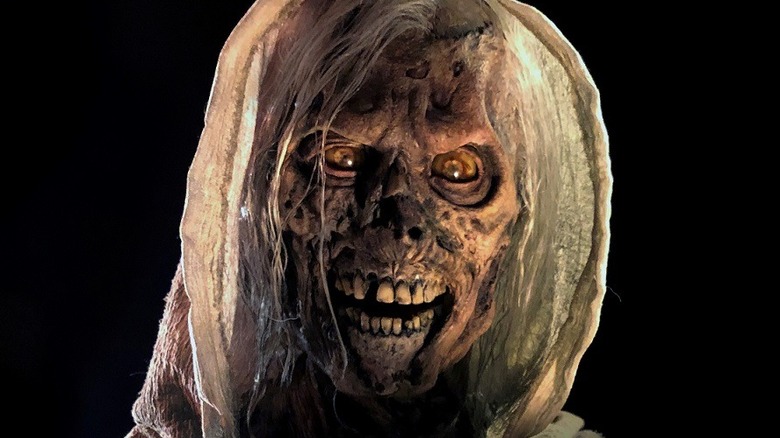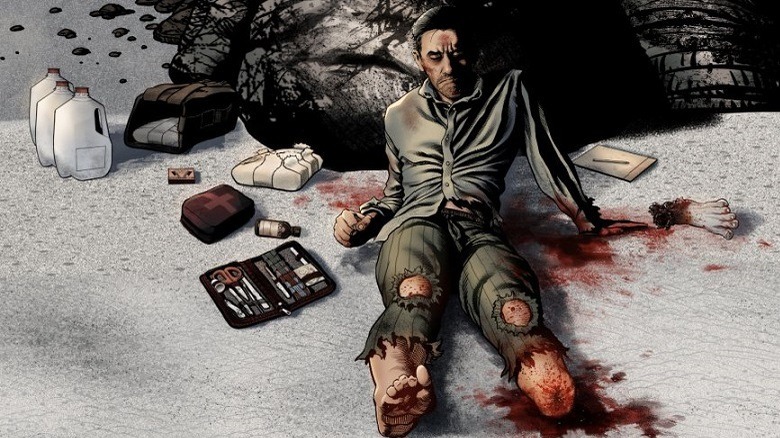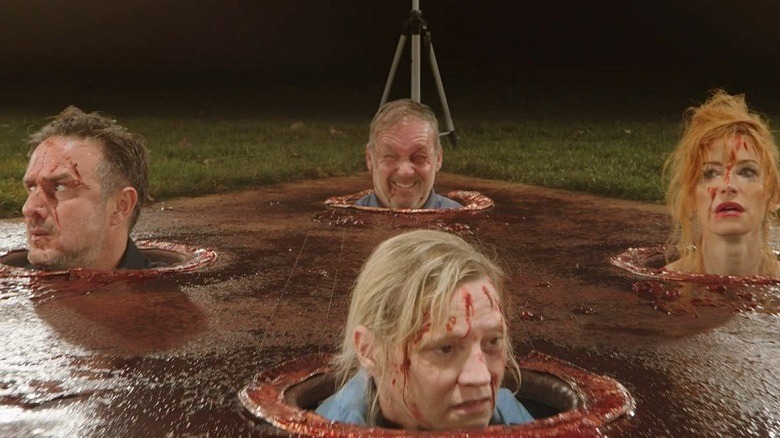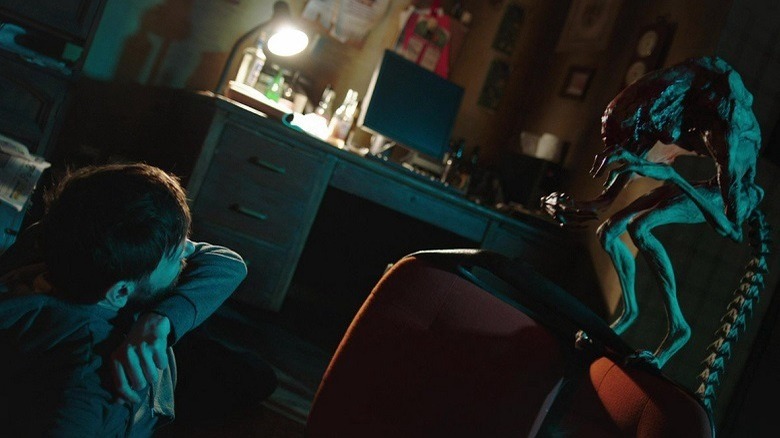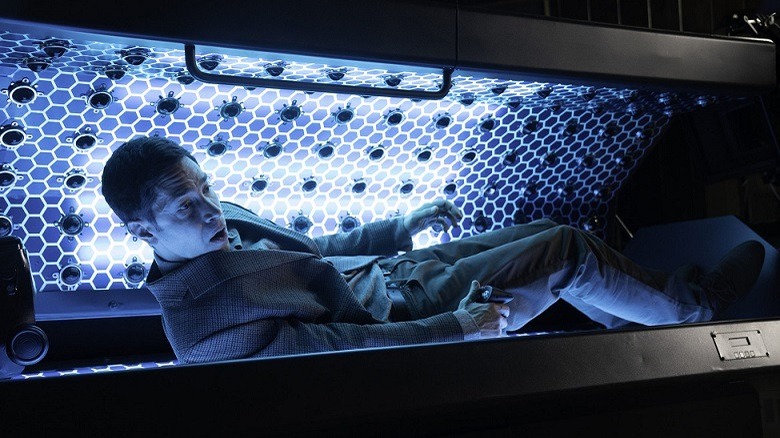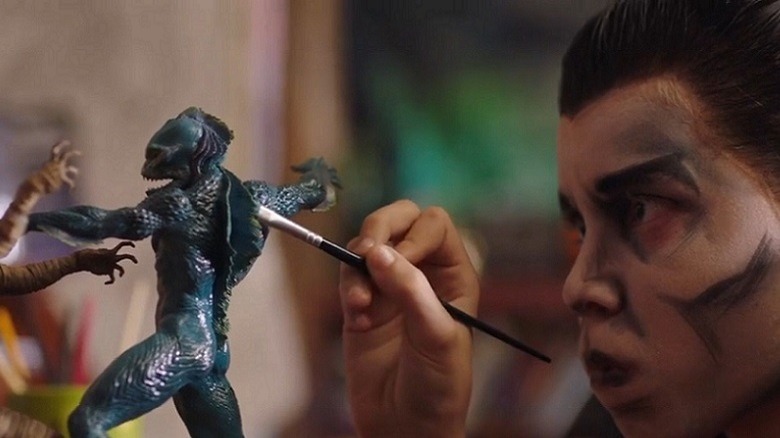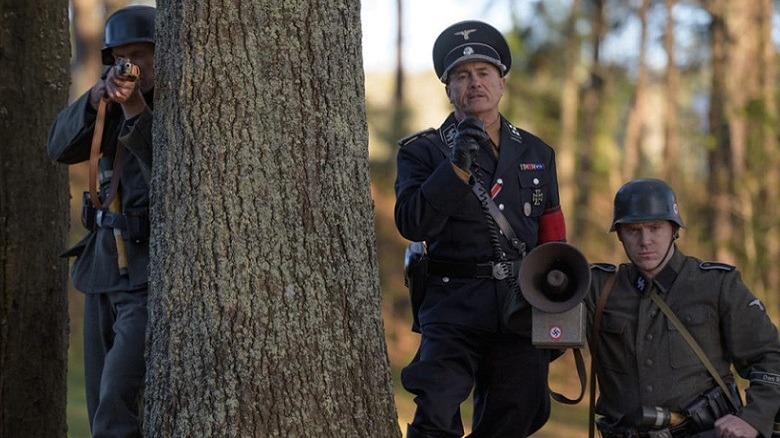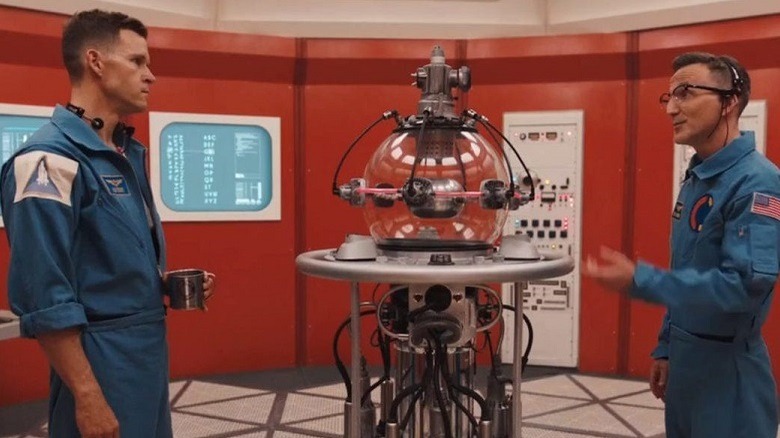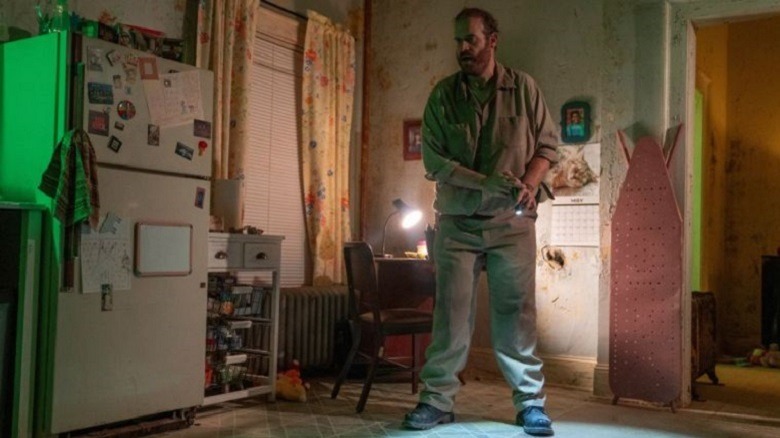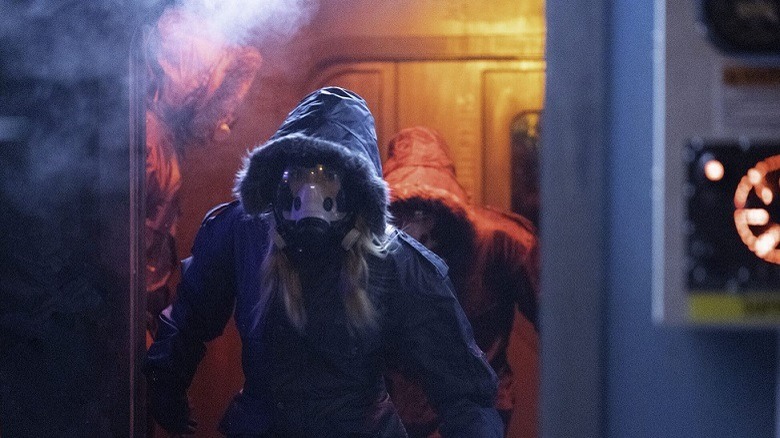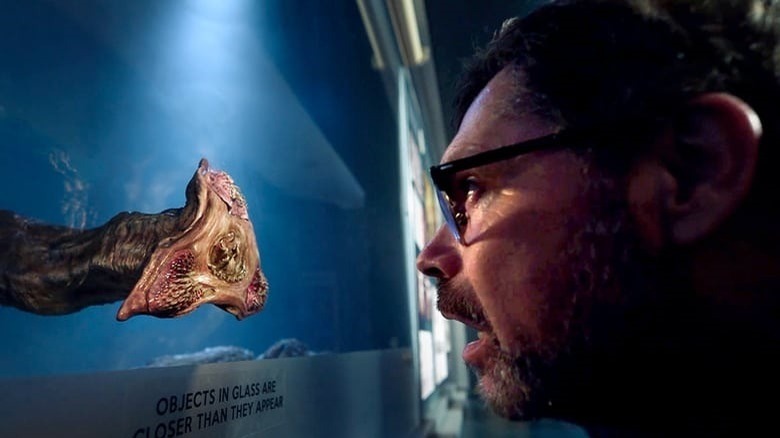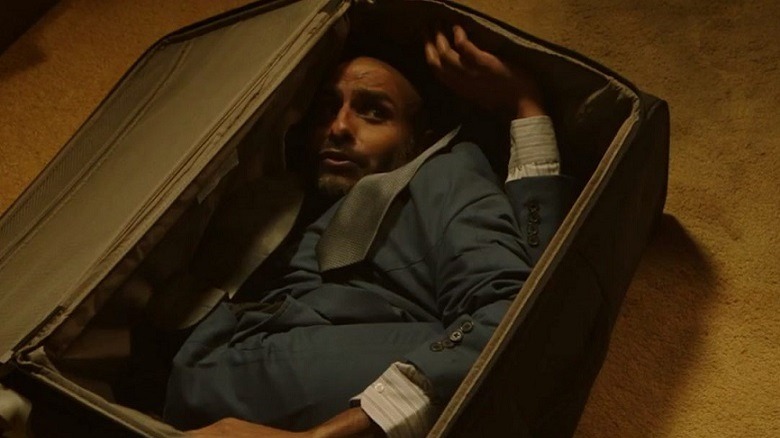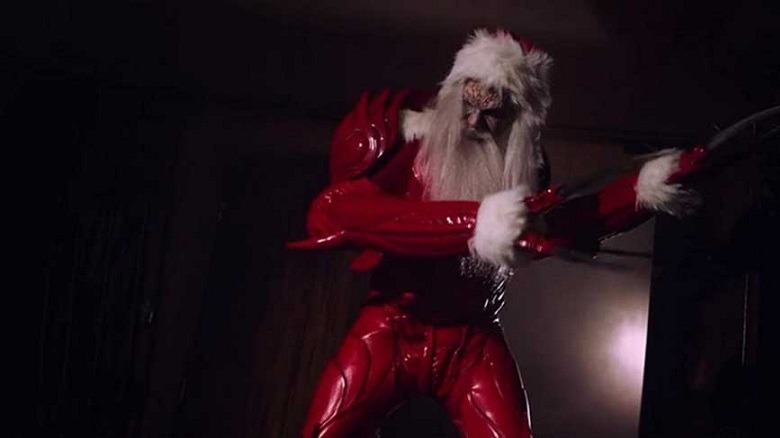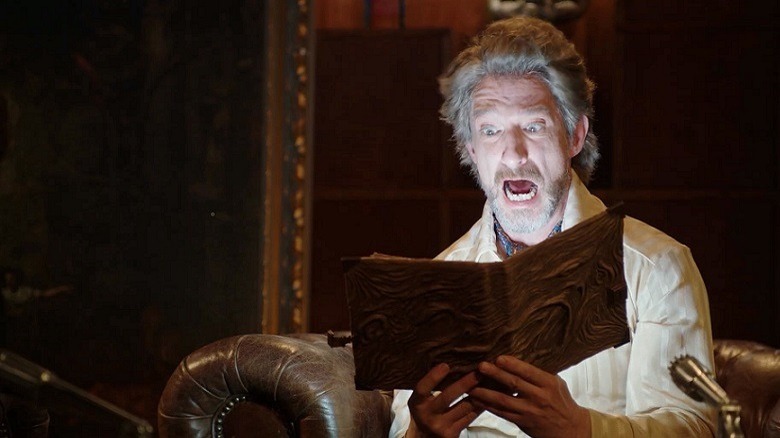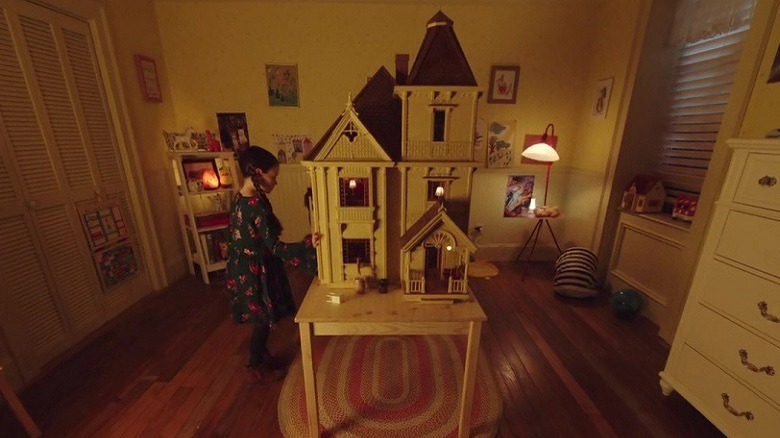The 14 Best Stories From Shudder's Creepshow Ranked
"Creepshow," the original 1982 movie, was the first collaboration between the sadly missed George A. Romero and Stephen King. A loving tribute to the old EC Horror comics of the '50s, the film would go on to spawn sequels of increasingly inferior quality, but in 2018 it was announced that "Creepshow" would be revived as a series, with "Walking Dead" producer Greg Nicotero serving as showrunner.
Horror anthology TV series are nothing new. Romero himself tried his hand with "Tales from the Darkside" (1983-1988), while the HBO series "Tales from the Crypt" had a successful run that spawned several spin-off movies between 1989 and 1996. But "Creepshow" attempts to imitate the horror comics that act as its source material. Shots are framed by borders with expositional text, or filmed at bizarre angles that mimic comic panels. Lighting is bold and garish, aping the basic four colors of old comics. Transitions often move between panels, as though the viewer is flicking between pages, and each scene opens with a painted picture that morphs into live action. It's a look that the television series pulls off well — sometimes, it's used to disguise a lesser budget, but it also gives "Creepshow" a distinctive look of its own.
With the third season of "Creepshow" currently airing, let's take a look at the first two seasons and their accompanying specials and sort the horrific from the sublime.
14. Survivor Type
Adapted from the Stephen King short story of the same name, which can be found in the 1985 collection "Skeleton Crew," "Survivor Type" is the first segment from the two-part "Creepshow Animated Special." Presented as an excerpt from the diary of a doctor (voiced by Kiefer Sutherland) who finds himself marooned on a tiny Pacific Island with few supplies, it's a grisly little tale of defiance and desperation.
It's one of the darkest "Creepshow" tales — even Stephen King thinks he went a little too far in the original prose — but is sadly let down through the execution (please forgive the pun). It's less cartoon, more motion comic, coming across as a weird hybrid of traditional animation and the house style used in Marvel's "What If..." It lacks the dynamism of a cartoon, feeling more like loosely animated illustrations from a book. The art is nice enough, but it feels somewhat cheap, like a missed trick.
Given the tale's brutal nature, though, it's reasonable that the only way to realistically make it for television was by animating it. Given the gore in the latter half, the story would probably be un-filmable in live action, or would run the risk of being banned from the outset.
13. Times Is Tough in Musky Holler
The short episode format can be a bit of a mixed blessing for "Creepshow." No episode is long enough to overstay its welcome, but it can, at times, feel exposition-heavy, with little time left for a payoff. Ironically, in "Times Is Tough in Musky Holler," there's too little explanation. Crucial exposition is delivered through comic panels, the viewer is expected to fill in the gaps, and it all feels a little bit rushed.
With a little more breathing room, this story from the 5th episode of the 1st season would have placed higher. However, as it stands, we hit the ground running and are quickly introduced to our protagonists, all prisoners awaiting their fate, and none too happy about it. There's a right-wing news anchor, the town's mayor, and a police sheriff, all awaiting punishment for their crimes.
And boy, what punishment. We learn about an apocalypse, and how these particularly loathsome individuals used the end of the world to take over — and subsequently lost control of — a town. They're suspended in the air, heads poking through holes in the ground as a group of bloodthirsty zombies stumble towards them. "Musky Holler" is an average episode saved by a particularly gruesome final shot, which somehow makes it all worthwhile.
12. The Finger
After finding a severed finger in the middle of the street, as you do, hoarder Clark Wilson decides to take it home. By accident, the bitter loner spills a few drops of beer on the appendage. To his amazement, it begins to regenerate. As time passes, it grows, first from a finger to a hand, then a hand to an arm, an arm to a torso — and ultimately into a bizarre, lizard-like creature named Bob. Clark soon learns that his unearthly pet will do anything for him. It starts leaving him gifts, and it quickly becomes apparent that this is a tale that will not end well for Clark.
Much like Stephen King's "The Lonesome Death of Jordy Verrill" in the original "Creepshow" movie, this episode gleefully breaks the fourth wall, using the technique to beneficial effect. As Clark, the always-entertaining D.J. Qualls addresses the audience directly; his performance elevates the material from schlock to something more darkly humorous. Add in some excellent practical puppeteering in the form of the twisted homunculus Bob, and the end result is something quite special. Even in the second segment of the very 2nd episode, Creepshow was already proving itself an entertaining watch, capable of taking risks in a well-trodden format.
11. Night of the Living Late Show
The final segment of Season 2, "Night of the Living Late Show" is lengthier than most "Creepshow" stories, taking up the entirety of the episode. Justin Long plays Simon, a man obsessed with the very real 1972 British movie "Horror Express." Simon has invented the Immersopod, a device that can place the occupant into a virtual reality version of a movie.
The story itself plays with a familiar "Creepshow" trope — obsession, in this case embodied by Simon's lust for the countess (Hannah Fierman) in the aforementioned movie — but it's given an interesting spin through the Immersopod. "Creepshow" seamlessly (well, almost seamlessly) incorporates modern-day footage of Simon with shots from the classic Christopher Lee and Peter Cushing horror film, and it's the interactions with the older movie that make this episode stand out.
"Night of the Living Late Show" is a fine enough tale, but would have benefited from a shorter run time. It's ultimately a classic theme wrapped in a flashy gimmick, and doesn't benefit from the extra length. Still, if the episode gets you to re-watch the excellent movie that inspired it, then job well done!
10. Model Kid
Somewhat reminiscent of the framing story from the original "Creepshow" movie, "Model Kid" tells the tale of a young child in the late '70s named Joe who is obsessed with collecting, building, and painting monster model kits. Troubled by a mother dying from a terminal illness and an abusive uncle, Joe increasingly retreats into the world of classic horror, which may eventually be his salvation.
In the same way that "Creepshow" is a loving homage to the horror comics of the '50s, "Model Kid" is a tribute to the classic Universal Monsters. It's a tale about finding solace in the garish worlds of horror, and, because no episode of "Creepshow" passes without a moral lesson of some kind, also a warning to those who would dare prey on the weak.
It's an excellent start to "Creepshow" Season 2, with Kevin Dillon in particularly fine, obnoxious form as Joe's loutish uncle, a character with very few redeeming qualities.
9. Bad Wolf Down
The first segment from the 2nd episode of Season 1, "Bad Wolf Down" continues the series' strong start. It's World War II, and a group of American soldiers are trapped behind enemy lines in an abandoned police station. Pinned down by the Nazis, the desperate troops are forced to consider drastic and ungodly measures to save themselves. What could have been an average werewolf tale is livened up considerably by both the appearance of genre stalwart Jeffrey Combs and also some excellent flick-book style transformation effects.
The transformation may be seen by cynics as a cost-cutting exercise, but it works to the segment's advantage — a lovely touch is how no two werewolves look alike, each taking inspiration from a different source. The tale feels ripped from the comics of the '50s, a lovely blend of EC Horror meets Sgt. Rock. Besides, watching Nazis get disemboweled never gets old.
8. The Right Snuff
Arriving halfway through the 2nd season of "Creepshow," "The Right Snuff" is the series' first foray into the vastness of space. The show's typical budget constraints could have either made or broken the episode; luckily, the prop and set designers went all out to make an effective and realistic looking spacecraft interior.
"The Right Snuff" (a play on "The Right Stuff," the title of Tom Wolfe's book about the Mercury Seven astronauts and its film adaptation) tells the tale of two men on a mission in space. They're there to test a revolutionary new gravitation device, but it soon becomes clear that one of them has an inferiority complex, desperate to prove himself to pull out of the gravitational pull of his father's lofty expectations. It's a tale of jealousy, betrayal, and poetic justice.
Somewhat predictable yet thoroughly entertaining, "The Right Snuff" stands out amongst "Creepshow" segments for not only the novel setting but also the amazing design of the creature at the episode's conclusion — laughably cheap, but brilliantly effective.
7. Pipe Screams
Featuring horror stalwart Barbara Crampton as evil landlord Victoria, this late 2nd season tale features probably the most revolting creature seen in the Creepshow franchise since the oil slick monster in the otherwise underwhelming "Creepshow 2."
Crampton's Victoria owns a rundown apartment complex with a pest problem, and summons hapless plumber Linus to sort out the pipework in her decrepit building. She's utterly revolting — when she's not breaking the law over her upkeep of the building, she's being horrifically racist about the poor people who pay rent. But this is "Creepshow," and it goes without saying that she gets her comeuppance — it's the nature of the beast responsible for her grisly demise that makes this episode a great watch.
If you're squeamish about the hair in your shower drain or the sludge in your washing machine's pipes, you might want to give "Pipe Screams" a wide berth. And if you do watch it, you'll probably want to get everything cleaned as quickly as you possibly can. A simple monster tale at heart, but a gloriously funny and gross one, this is classic "Creepshow."
6. Within the Walls of Madness
We're approaching the end of Season 2 now, and with it one of the most ambitious "Creepshow" stories yet. In "Within the Walls of Madness," we meet Zeller, a man awaiting his execution. Accused of murdering his companions at an arctic research center in cold blood, Zeller relates a tale of arcane science, dimensional abominations, and curiosity gone too far.
Even if the title wasn't an obvious homage to "At the Mountains of Madness," this tale would be unashamedly Lovecraftian, borrowing some elements of "The Thing" along the way. It's more of a conventional tale than standard "Creepshow" fare, eschewing the typical twist ending in favor of a well-plotted narrative and superlative practical effects work with no shortage of suitably squamous tentacles.
If anything, the brevity of the segment is the weak point. "Within the Walls of Madness" is too big for "Creepshow," and would have benefited from being stretched out to a full episode, as opposed to just a second, albeit satisfying, half.
5. Skincrawlers
The first segment of the closing episode of Season 1 strips "Creepshow" to its core: an entertaining monster story with some appropriately gruesome deaths. Henry has been trying and failing to lose weight, and is looking for a new solution. Meanwhile, Doctor Sloan has a revolutionary new weight-loss technique: leeches that literally eat the fat right off you. Henry is initially reticent to try something so extreme, but finds himself tempted after seeing the results on a friend. As any horror fan knows, anything too good to be true is always exactly that, but Henry's struggle sets the scene for a raucous and bloody final act that's well worth your time.
"Creepshow" often manages to work miracles with its relatively meager budget, and "Skincrawlers" is a wonderful example of how to do it right. Brilliant monster designs prop up a somewhat clunky and predictable plot, but the segment is nothing if not memorable.
4. The Man in the Suitcase
Common themes in many of EC's original horror comics are to be careful what you wish for, and to not be too greedy. This segment from the 3rd episode of "Creepshow" is a classic example.
Having returned home from holiday with the wrong suitcase, Justin opens the luggage to find a man squashed inside, still alive. "An unfortunate condition," the man relates, "causes me to produce gold when I am in pain." Tempted by these unique properties, Justin and two of his friends find themselves sorely tempted by the potential riches the man offers.
Part of the fun of "Creepshow" comes from predictability and inevitability; anybody familiar with this kind of story knows that terrible things will happen to greedy people. The fun is in not knowing how it'll happen. However, this time around, anyone with even a passing knowledge of twist endings can guess exactly how this tale will end — with "The Main in the Suitcase," the journey is the entertaining bit.
3. Shapeshifters Anonymous
Benefitting from extra length, the single story in "A Creepshow Holiday Special" is an everyday tale about metamorphs and psychotic Santas. Based on the 2011 novella of the same name by J.A. Konrath, "Shapeshifters Anonymous" follows our lead, Robert, who fears that he is responsible for murder and attends a meeting of the eponymous organization to seek answers.
One of the benefits of having a format with a very loose theme — in this case, horror — is that "Creepshow" can tell a myriad of different stories. "Shapeshifters Anonymous" is the funniest and most outlandish "Creepshow" segment to date, cramming as many ideas into its 46-minute running time as many shows do across the entire series.
Never taking itself too seriously, the organization consists of a motley crew of misfits; it turns out that the "Were-" prefix isn't limited to wolves. You'll learn why shapeshifters don't feature in any passages in the Bible, and that mall Santas are part of an ancient organization that's as old as history. It feels like nothing "Creepshow" has done before, but also seems right at home.
2. Public Television of the Dead
Forcing itself to almost the top of this list through sheer daring alone, the second segment from the Season 2 premiere is as audacious as it is unexpected. Nobody was bold enough to ask for an official "Creepshow" and "Evil Dead" crossover, but that's exactly what this episode delivered.
We're in the studios of the WQPS Pittsburgh public television network, witnessing the recording of an antique show. Ted Raimi (brother of director Sam, playing himself) has brought a book along, hoping that its value will be appraised. It turns out that said book is the Necronomicon, and reading it out loud turns cast and crew into ravenous Deadites.
A group of survivors, including a veteran suffering from PTSD and a Bob Ross analogue, are forced to team up against the forces of the undead. Ever wondered how Shari Lewis' Lamb Chop would have behaved if possessed by a Kandarian demon? Wonder no more. "Public Television of the Dead" is raucous, bloody, hilarious, and "Creepshow" at its absolute best.
1. The House of the Head
The second part of the first ever episode of "Creepshow" gave a tantalizing glimpse at what this series could achieve when adapting existing material for the small screen — in this case, Josh Malerman's ("Bird Box") short story of the same name. Evie has a huge dollhouse in her room, containing a miniature family she has named the SmithSmiths. As with any girl and her dolls, she plays with them, making them have lunch and watch television, and providing them with a normal, run-of-the-mill life. But then, one day, a tiny severed head appears in the house. It was not placed there by Evie or by her family. It's simply there. And life in the dollhouse is never quite the same.
"The House of the Head" has no gore, no profound twist, no particular threat, and no real shocks to speak of, but it's one of the most uncomfortable 20 minutes of television I've sat through. Your mileage may vary, but this episode felt like prime "Creepshow" — smart, unnerving, and thought-provoking. It's a shame that many of the other "Creepshow" episodes adapted from works by known genre authors have turned out disappointing and formulaic, but this one was like nothing I've seen before or since — and the dollhouse is going out to the shed, possibly for firewood.
